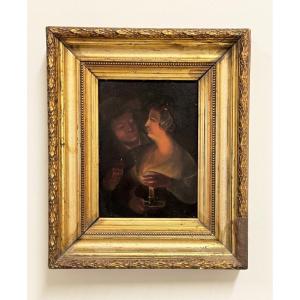(Paris 1817 - c.1876)
The Cup arriving at his sister's house in Sorrento
Oil on canvas
H. 49 cm; L. 37.5 cm
Signed lower right
Exhibition : 1852, Salon de Paris, under number 959
Related work : Engraving by Jean-Denis Nargeot in 1852
Bibliography : L'Illustration, April 24, 1852, engraved by Best, Hottelin and Regnier, from a drawing by Valentin) and reproduced on p.260, cited on p.262; La Mode: Political, religious and literary review, 1852, cited; Journal des Demoiselles, 1852, engraved by Nargeot and reproduced; Almanac of Literature, Theater and Fine Arts, 1853, p.35, cited.
A pupil of Léon Cogniet, Jules Naudin began at the Paris Salon in 1838 and exhibited there until 1876, the supposed year of his death, mainly portraits and religious or historical subjects. In 1838 and 1841, he competed for the Grand Prix de Rome for painting at the School of Fine Arts and won a Second Grand Prix in 1841. His wife Henriette Demours gave him a son born in 1853, Charles Edouard, who will move towards sculpture and architecture after training at the Beaux-Arts in Paris. Charles-Edouard will bequeath to the Louvre a series of drawings by his father representing Italians in regional costumes, located on each sheet. This donation testifies to Naudin's travels in Italy and therefore to the stylistic reality of his compositions, of which our canvas is an example. In 1852, he was commissioned for the Hospice de Mont Genèvre to make a copy of David's painting representing Bonaparte crossing the Great Saint Bernard. A few years later, Christ who covers the poor and orphans with his mantle will be acquired by the State and placed in the Saint Front church in Ribérac (Dordogne), just like The Virgin with the Child Jesus who plucks a branch of cypress, which will join the church of Luzarches (Val d'Oise) following the Salon of 1865. Two years later, the State buys him an Ecce Homo, then placed in the chapel of the Lycée de Clermont-Ferrand. Our painting must have had some success at the Salon of 1852 since it was engraved twice and published in L'Illustration and the Journal des Demoiselles. The Illustration describes it thus: “This little picture is quite well composed, and can furnish the subject of a pleasant engraving; but there is reason to reproach painting for the equality of the smooth touch and the uniformity of the hue, whatever the variety of objects, flesh, fabrics or ground ”. The critical article on the 1852 Salon of L'Almanach de la Littérature, du Théâtre et des Beaux-Arts distinguishes our work, in the category of genre paintings, as one of those "having received the votes of the connoisseur public". Likewise, our painting stood out in the article on the Salon which appeared in the July 5, 1852 issue of La Mode: political, religious and literary review: “We have rid of this inextricable jumble of mediocrity a painting by Mr. Jules Naudin, who has qualities… ”, being part of“… those which seemed to us the most deserving to be pointed out for public scrutiny ”. Our work represents the moment when, in 1577, the famous Italian poet Torquato Tasso dit Le Tasse (born in Sorrento in 1544), when he was imprisoned in Ferrara by the Este family following an incident, escaped and comes to join his sister Cornélia living in Sorrento in November. Welcomed with kindness, he stayed with her for some time, but decided to go to Rome at the end of January 1578. The incredible life of Tasso would be illustrated by many artists in the 19th century, between 1810 and 1870, in the painting of history in France, at a time when his work is experiencing renewed interest: Menjaud, Franquelin, Fleury Richard, Dejuinne, Larivière, Clérian, Achille Deveria, Granet, Louis Gallait, Eugène Delacroix ... As for our subject in particular, it is first treated by Louis Ducis in 1812 (the painting will be bought by the Empress Joséphine), in a cycle dedicated to Tasso, then by Alfred de Curzon in 1859 (cited above) or by Nicaise de Kayser ( Cornilliet draws an engraving from it exhibited at the Salon of 1863). The booklet for the Salon of 1812 thus captioned Ducis' painting: “On returning home, he announced himself as a messenger who brought her news of his brother. His sister did not recognize him; she opened the letter in which the unfortunate Torquato pictured himself in the most cruel position. The tender Cornelia, on reading this frightening news, testified such a sharp pain that Tasso could not support her disguise and hastened to console her by throwing himself into his arms ”. In 1859, Curzon's painting is described as follows: “Misguided by his sickly imagination, he had fled from Ferrara. He arrives at his sister's, disguised as a shepherd, and presents her with a letter in which he says he is in the greatest danger. In pain, Cornélie is going to faint. The Cup throws down her coat, makes herself known and holds her in his arms ”.


























 Le Magazine de PROANTIC
Le Magazine de PROANTIC TRÉSORS Magazine
TRÉSORS Magazine Rivista Artiquariato
Rivista Artiquariato
